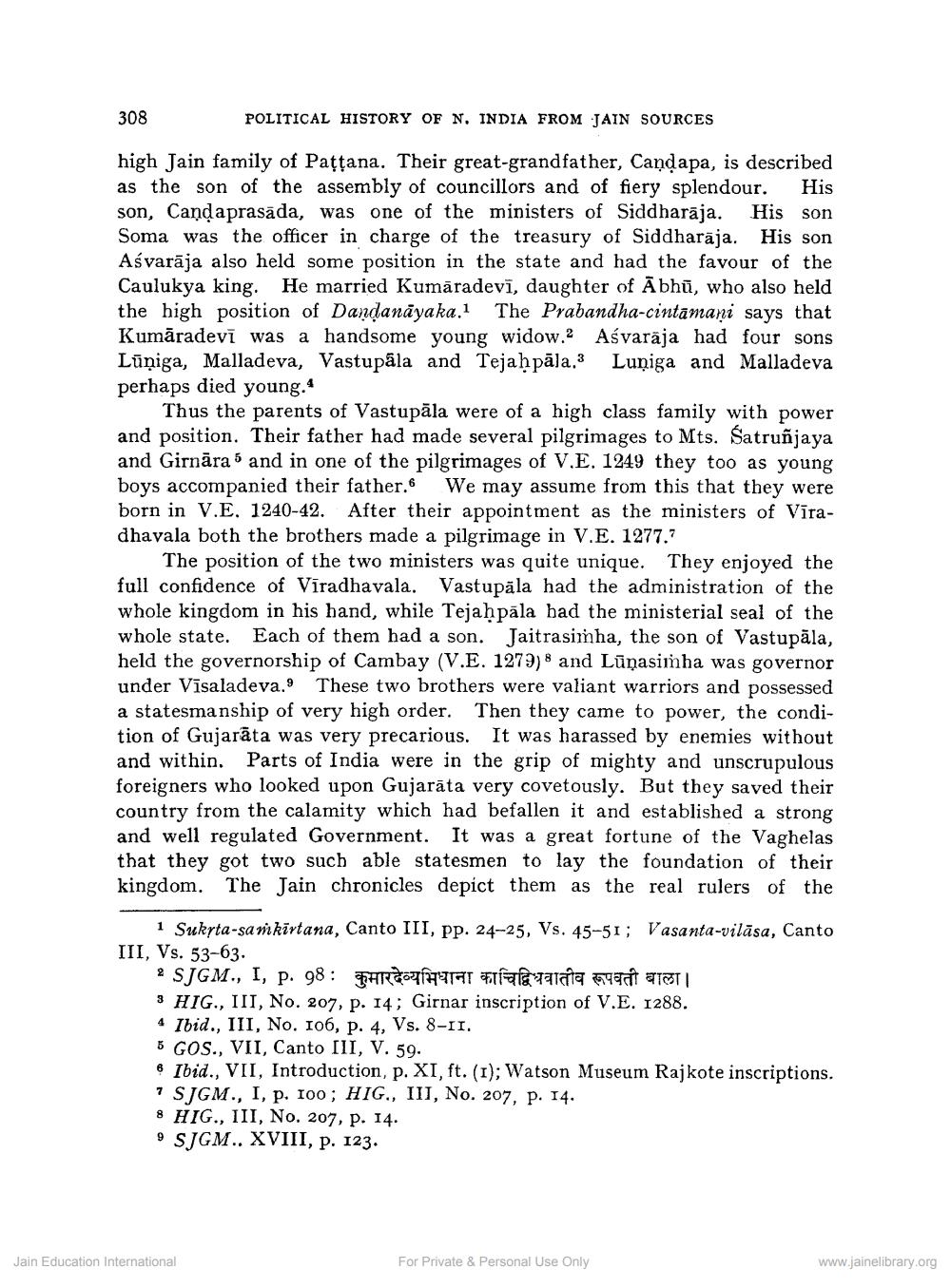________________
308
POLITICAL HISTORY OF N, INDIA FROM JAIN SOURCES
high Jain family of Pațţana. Their great-grandfather, Caņdapa, is described as the son of the assembly of councillors and of fiery splendour. His son, Candaprasāda, was one of the ministers of Siddharāja. His son Soma was the officer in charge of the treasury of Siddharāja. His son Asvarāja also held some position in the state and had the favour of the Caulukya king. He married Kumāradevī, daughter of Ābhū, who also held the high position of Dandanāyaka.1 The Prabandha-cintamani says that Kumāradevi was a handsome young widow.2 Aśvaraja had four sons Lūņiga, Malladeva, Vastupala and Tejahpāla.3 Luniga and Malladeva perhaps died young. 4
Thus the parents of Vastupāla were of a high class family with power and position. Their father had made several pilgrimages to Mts. Satruñjaya and Girnāra) and in one of the pilgrimages of V.E. 1249 they too as young boys accompanied their father. We may assume from this that they were born in V.E. 1240-42. After their appointment as the ministers of Vīradhavala both the brothers made a pilgrimage in V.E. 1277.7
The position of the two ministers was quite unique. They enjoyed the full confidence of Vīradhavala. Vastupāla had the administration of the whole kingdom in his hand, while Tejahpāla had the ministerial seal of the whole state. Each of them had a son. Jaitrasimha, the son of Vastupāla, held the governorship of Cambay (V.E. 1279) 8 and Lūņasimha was governor under Vīsaladeva.9 These two brothers were valiant warriors and possessed a statesmanship of very high order. Then they came to power, the condition of Gujarāta was very precarious. It was harassed by enemies without and within. Parts of India were in the grip of mighty and unscrupulous foreigners who looked upon Gujarāta very covetously. But they saved their country from the calamity which had befallen it and established a strong and well regulated Government. It was a great fortune of the Vaghelas that they got two such able statesmen to lay the foundation of their kingdom. The Jain chronicles depict them as the real rulers of the
1 Sukrta-sankirtana, Canto III, pp. 24-25, Vs. 45-51; Vasanta-vilāsa, Canto III, Vs. 53-63.
2 SJGM., I, p. 98: Fr & ATT Flataia Gracia 3 HIG., III, No. 207, p. 14; Girnar inscription of V.E. 1288. 4 Ibid., III, No. 106, p. 4, Vs. 8-II. 5 GOS., VII, Canto III, V. 59. 6 Ibid., VII, Introduction, p. XI, ft. (I); Watson Museum Rajkote inscriptions. ? SJGM., I, p. 100; HIG., III, No. 207, p. 14. 8 HIG., III, No. 207, p. 14. 9 SJGM.. XVIII, p. 123.
Jain Education International
For Private & Personal Use Only
www.jainelibrary.org




